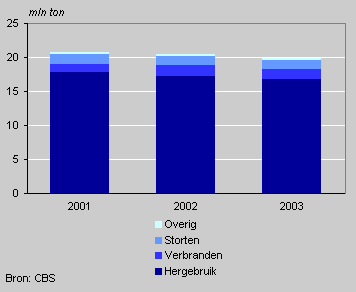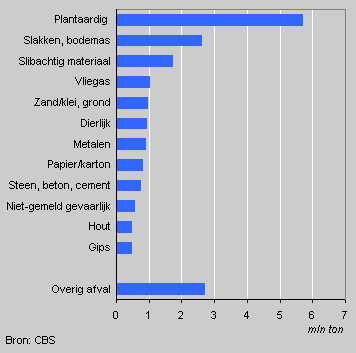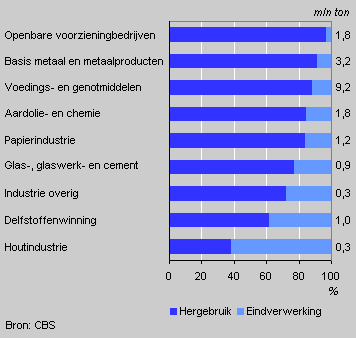Industrial waste continues to decrease

In 2003 Dutch industry produced 19.8 million tons of industrial waste, 3 percent less than in 2002. It was for the second year in a row that the volume of industrial waste decreased.
Industrial waste by processing

About 85 percent of waste is recycled. The rest finds its way to incineration (7 percent) and dumping sites (6 percent).
Industrial waste composition, 2003

Much industrial waste from food industry
Almost half of all industrial waste comes from the food, beverages and tobacco industries. Most of this waste served as raw material for fodder, or is used as fertiliser in agriculture. Over 15 percent of industrial waste comes from the metal industry. Utility companies and the oil, chemicals and plastics industries generate almost 10 percent of industrial waste each.
The industrial branches producing most industrial waste also recycle most.
Industrial waste by industry, 2003

Recycling
Utility companies have a 97 percent top score in recycling. Slag, fly ash and desulphurised gypsum from coal-fired electricity plants are largely used in road construction and in the cement or gypsum industry. The metal slag from the base metal industry is reused in the cement industry and in road construction and hydraulic engineering works.
The oil and chemical industries mainly produce sulphur and phosphor containing slag. The sulphur residues are used in the production of matches, rubber and sulphuric acid. The slag is used in road construction, or costal and shore reinforcement.
Some industrial branches recycle very little. Much of the waste in the wood industry, such as chips, leftovers and dust, are burned. Waste produced in mining and extraction (rock, grit, rinsing water) is often unfit for re-use and is mainly dumped or discharged into the sea.
René Jolly